2021 TOYOTA AYGO tire pressure
[x] Cancel search: tire pressurePage 411 of 546
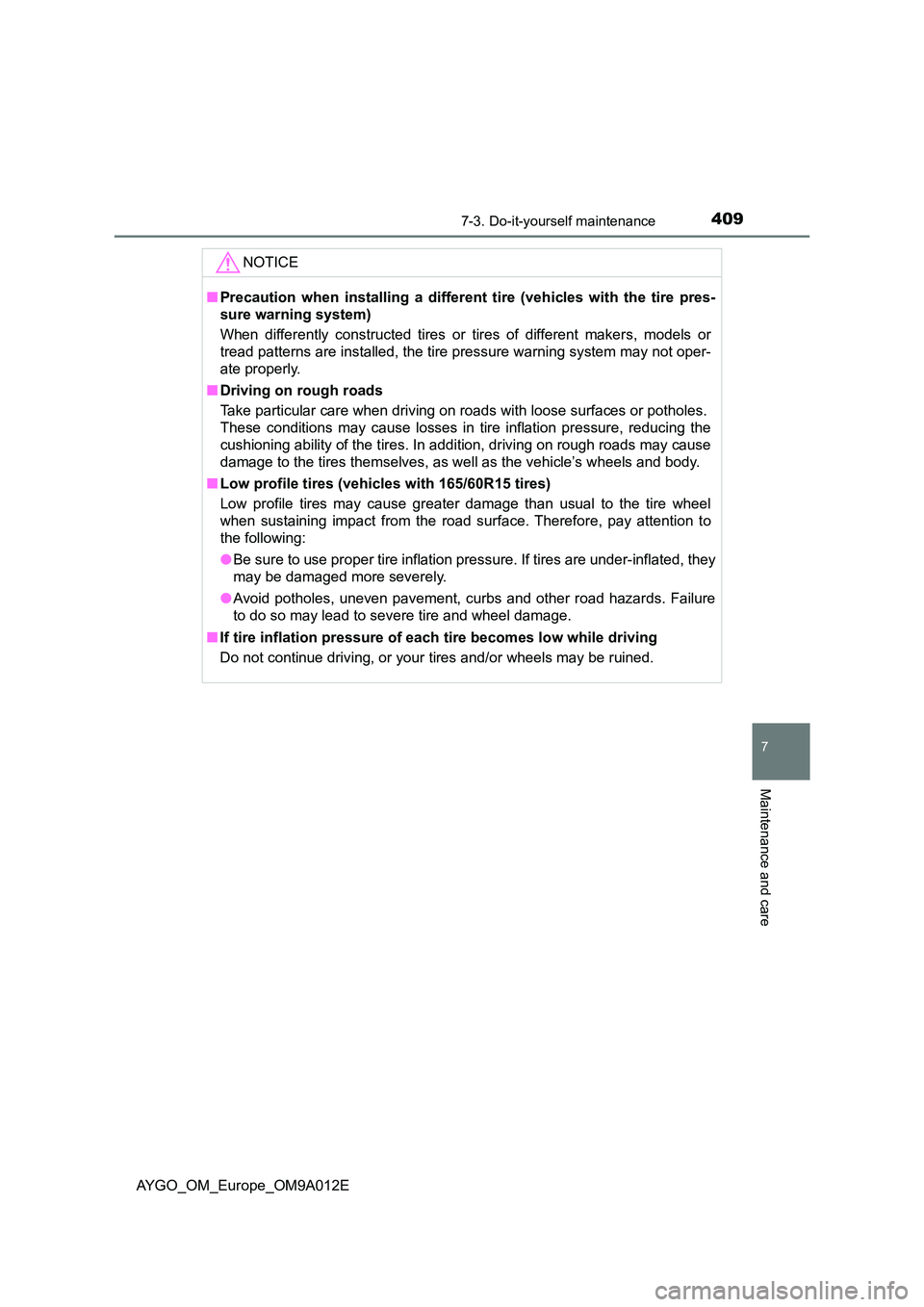
4097-3. Do-it-yourself maintenance
7
Maintenance and care
AYGO_OM_Europe_OM9A012E
NOTICE
■Precaution when installing a different tire (vehicles with the tire pres-
sure warning system)
When differently constructed tires or tires of different makers, models or
tread patterns are installed, the tire pressure warning system may not oper-
ate properly.
■ Driving on rough roads
Take particular care when driving on roads with loose surfaces or potholes.
These conditions may cause losses in tire inflation pressure, reducing the
cushioning ability of the tires. In addition, driving on rough roads may cause
damage to the tires themselves, as well as the vehicle’s wheels and body.
■ Low profile tires (vehicles with 165/60R15 tires)
Low profile tires may cause greater damage than usual to the tire wheel
when sustaining impact from the road surface. Therefore, pay attention to
the following:
● Be sure to use proper tire inflation pressure. If tires are under-inflated, they
may be damaged more severely.
● Avoid potholes, uneven pavement, curbs and other road hazards. Failure
to do so may lead to severe tire and wheel damage.
■ If tire inflation pressure of each tire becomes low while driving
Do not continue driving, or your tires and/or wheels may be ruined.
Page 412 of 546
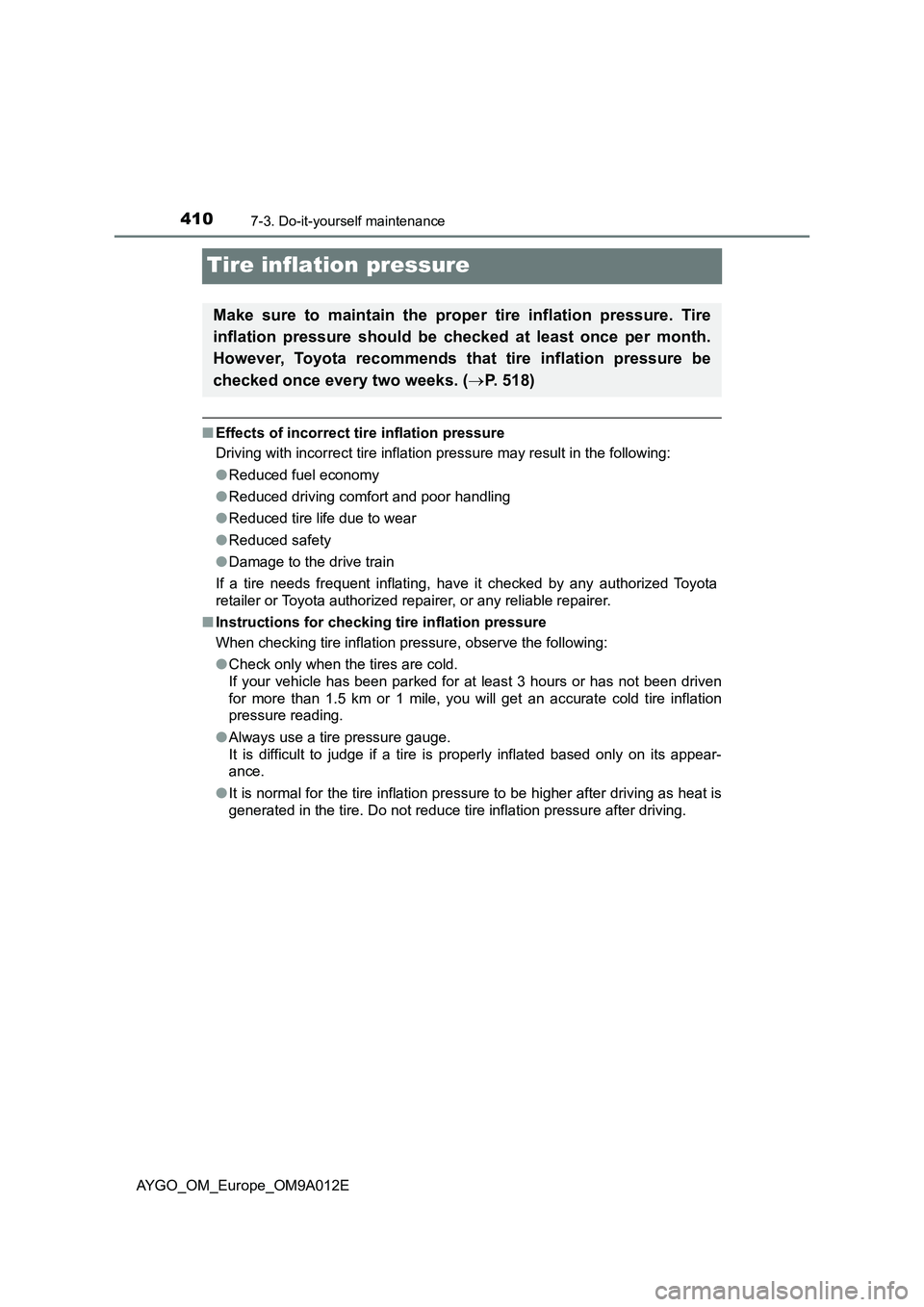
4107-3. Do-it-yourself maintenance
AYGO_OM_Europe_OM9A012E
Tire inflation pressure
■Effects of incorrect tire inflation pressure
Driving with incorrect tire inflation pressure may result in the following:
●Reduced fuel economy
●Reduced driving comfort and poor handling
●Reduced tire life due to wear
●Reduced safety
●Damage to the drive train
If a tire needs frequent inflating, have it checked by any authorized Toyota
retailer or Toyota authorized repairer, or any reliable repairer.
■Instructions for checking tire inflation pressure
When checking tire inflation pressure, observe the following:
●Check only when the tires are cold.
If your vehicle has been parked for at least 3 hours or has not been driven
for more than 1.5 km or 1 mile, you will get an accurate cold tire inflation
pressure reading.
●Always use a tire pressure gauge.
It is difficult to judge if a tire is properly inflated based only on its appear-
ance.
●It is normal for the tire inflation pressure to be higher after driving as heat is
generated in the tire. Do not reduce tire inflation pressure after driving.
Make sure to maintain the proper tire inflation pressure. Tire
inflation pressure should be checked at least once per month.
However, Toyota recommends that tire inflation pressure be
checked once every two weeks. (P. 518)
Page 413 of 546
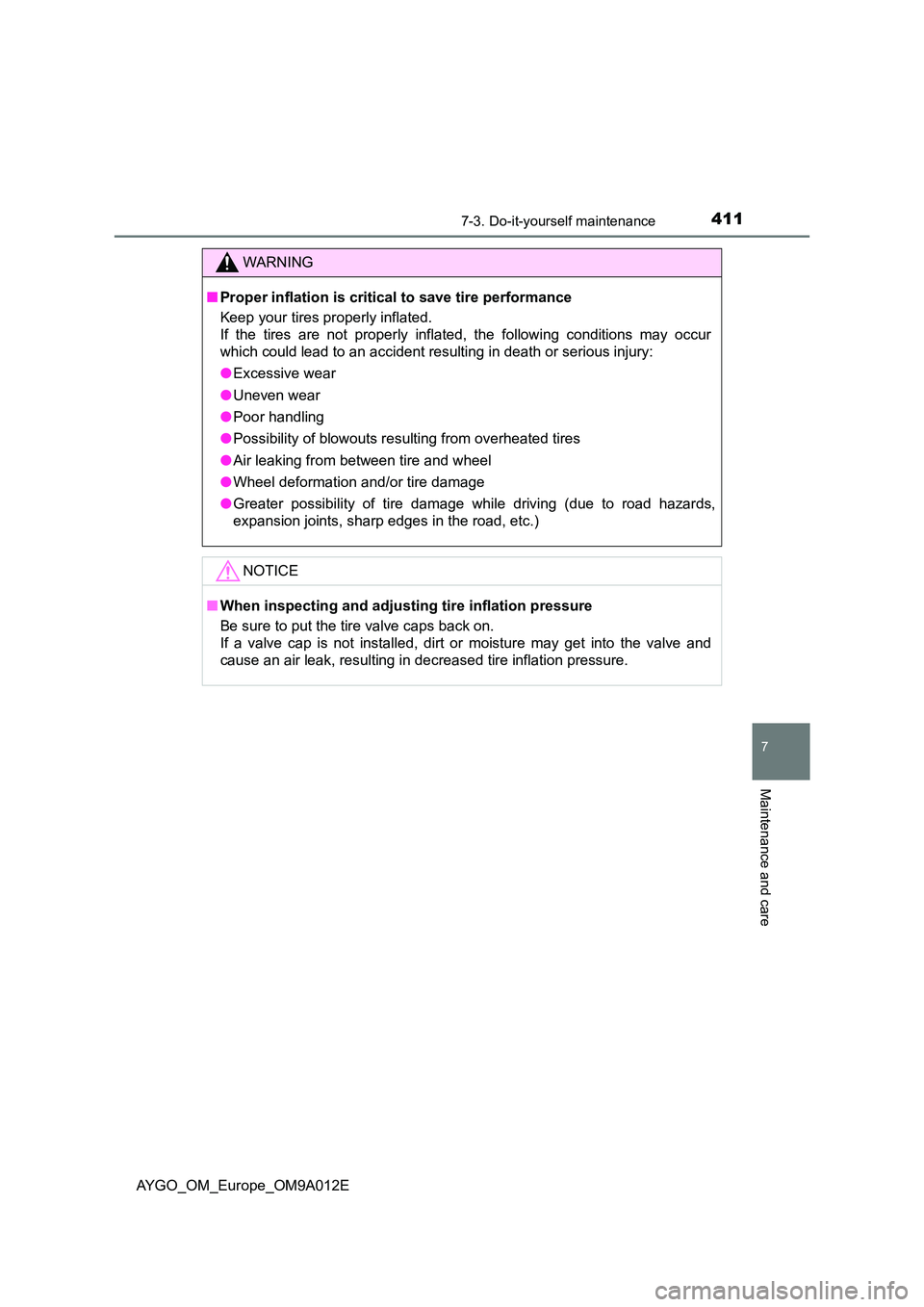
4117-3. Do-it-yourself maintenance
7
Maintenance and care
AYGO_OM_Europe_OM9A012E
WARNING
■Proper inflation is critical to save tire performance
Keep your tires properly inflated.
If the tires are not properly inflated, the following conditions may occur
which could lead to an accident resulting in death or serious injury:
● Excessive wear
● Uneven wear
● Poor handling
● Possibility of blowouts resulting from overheated tires
● Air leaking from between tire and wheel
● Wheel deformation and/or tire damage
● Greater possibility of tire damage while driving (due to road hazards,
expansion joints, sharp edges in the road, etc.)
NOTICE
■ When inspecting and adjusting tire inflation pressure
Be sure to put the tire valve caps back on.
If a valve cap is not installed, dirt or moisture may get into the valve and
cause an air leak, resulting in decreased tire inflation pressure.
Page 456 of 546
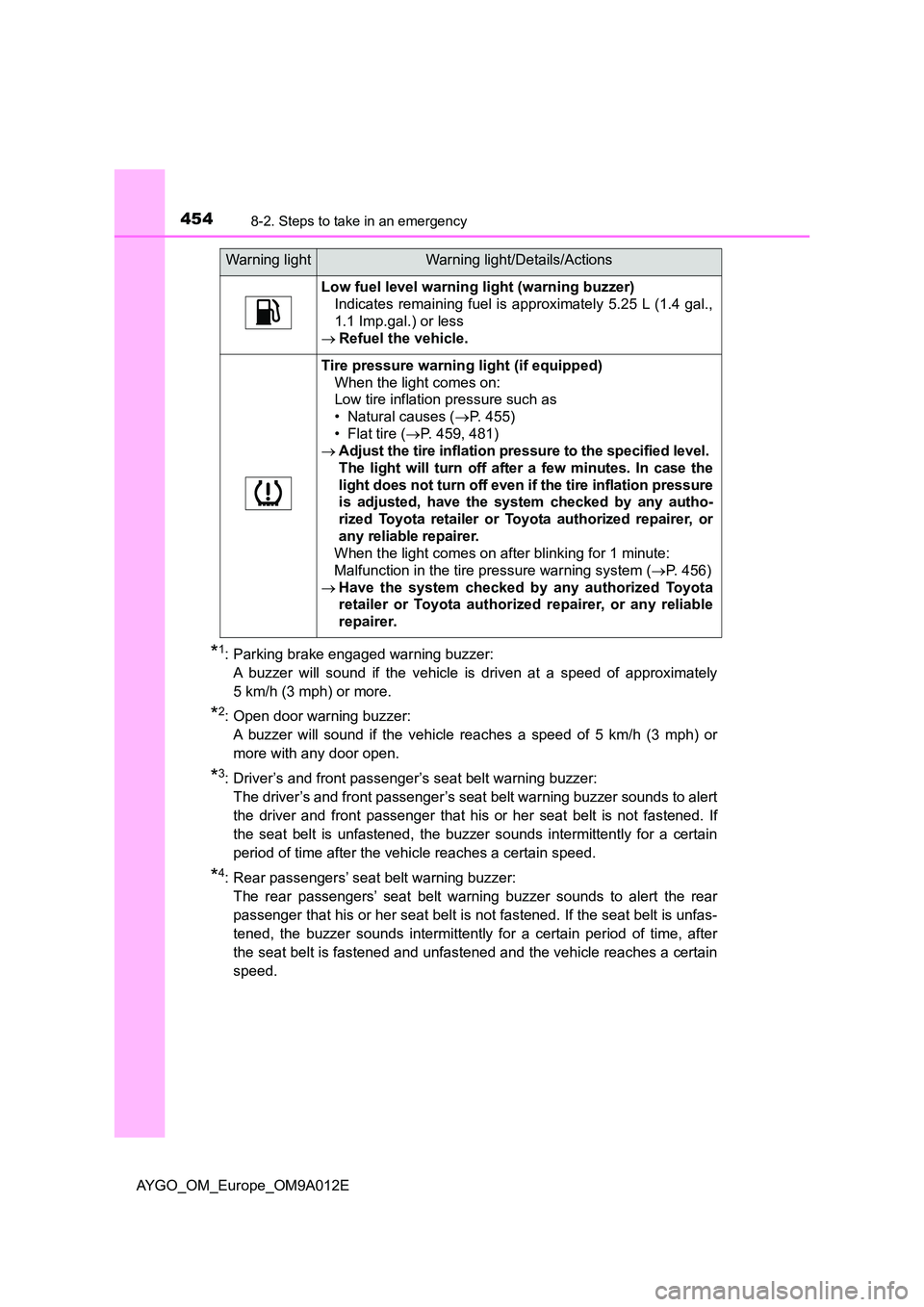
4548-2. Steps to take in an emergency
AYGO_OM_Europe_OM9A012E
*1: Parking brake engaged warning buzzer:
A buzzer will sound if the vehicle is driven at a speed of approximately
5 km/h (3 mph) or more.
*2: Open door warning buzzer:
A buzzer will sound if the vehicle reaches a speed of 5 km/h (3 mph) or
more with any door open.
*3: Driver’s and front passenger’s seat belt warning buzzer:
The driver’s and front passenger’s seat belt warning buzzer sounds to alert
the driver and front passenger that his or her seat belt is not fastened. If
the seat belt is unfastened, the buzzer sounds intermittently for a certain
period of time after the vehicle reaches a certain speed.
*4: Rear passengers’ seat belt warning buzzer:
The rear passengers’ seat belt warning buzzer sounds to alert the rear
passenger that his or her seat belt is not fastened. If the seat belt is unfas-
tened, the buzzer sounds intermittently for a certain period of time, after
the seat belt is fastened and unfastened and the vehicle reaches a certain
speed.
Low fuel level warning light (warning buzzer)
Indicates remaining fuel is approximately 5.25 L (1.4 gal.,
1.1 Imp.gal.) or less
Refuel the vehicle.
Tire pressure warning light (if equipped)
When the light comes on:
Low tire inflation pressure such as
• Natural causes ( P. 455)
• Flat tire ( P. 459, 481)
Adjust the tire inflation pressure to the specified level.
The light will turn off after a few minutes. In case the
light does not turn off even if the tire inflation pressure
is adjusted, have the system checked by any autho-
rized Toyota retailer or Toyota authorized repairer, or
any reliable repairer.
When the light comes on after blinking for 1 minute:
Malfunction in the tire pressure warning system ( P. 456)
Have the system checked by any authorized Toyota
retailer or Toyota authorized repairer, or any reliable
repairer.
Warning lightWarning light/Details/Actions
Page 457 of 546

4558-2. Steps to take in an emergency
8
When trouble arises
AYGO_OM_Europe_OM9A012E
■To prevent the clutch from overheating (vehicles with a multi-mode man-
ual transmission)
● Do not use the accelerator pedal or starting assist system to hold the vehicle
on a hill.
● On an uphill incline, observe the following whenever possible:
• Maintain a safe distance from the vehicle ahead and avoid unnecessary
starting off and stopping.
• Avoid using E mode on an uphill slope. This will help to avoid unneces-
sary gear changes.
■ Front passenger detection sensor, seat belt reminder and warning
buzzer
● If luggage is placed on the front passenger seat, the front passenger detec-
tion sensor may cause the warning light to flash and the warning buzzer to
sound even if a passenger is not sitting in the seat.
● If a cushion is placed on the seat, the sensor may not detect a passenger,
and the warning light may not operate properly.
■ If the malfunction indicator lamp comes on while driving
The malfunction indicator lamp will come on if the fuel tank becomes com-
pletely empty. If the fuel tank is empt y, refuel the vehicle immediately. The
malfunction indicator lamp will go off after several trips.
If the malfunction indicator lamp does not go off, contact any authorized
Toyota retailer or Toyota authorized repai rer, or any reliable repairer as soon
as possible.
■ Electric power steering system warning light (warning buzzer)
When the battery charge becomes insufficient or the voltage temporarily
drops, the electric power steering system warning light may come on and the
warning buzzer may sound.
■ When the tire pressure warning light comes on (vehicles with the tire
pressure warning system)
Inspect the appearance of the tire to check that the tire is not punctured.
If the tire is punctured: P. 459, 481
If the tire is not punctured:
Check the tire inflation pressure after the tire temperature has lowered suffi-
ciently. Adjust the inflation pressure to the appropriate level and carry out ini-
tialization. ( P. 4 0 6 )
■ The tire pressure warning light may come on due to natural causes
(vehicles with the tire pressure warning system)
The tire pressure warning light may come on due to natural causes such as
natural air leaks and tire inflation pressure changes caused by temperature.
In this case, adjusting the tire inflation pressure is at the specified level and
carry out initialization. ( P. 406)
Page 458 of 546

4568-2. Steps to take in an emergency
AYGO_OM_Europe_OM9A012E
■ If the tire pressure warning light frequently comes on after blinking for
1 minute (vehicles with a tire pressure warning system)
If the tire pressure warning light frequently comes on after blinking for 1 min-
ute when the engine switch is turned on, have it checked by any authorized
Toyota retailer or Toyota authorized repairer, or any reliable repairer.
■ Warning buzzer
In some cases, the buzzer may not be heard because of noisy place or an
audio sound.
WARNING
■ If both the ABS and the brake system warning lights remain on
Stop your vehicle in a safe place immediately and contact any authorized
Toyota retailer or Toyota authorized r epairer, or any reliable repairer. The
vehicle will become extremely unstable during braking, and the ABS system
may fail, which could cause an accident resulting in death or serious injury.
■ When the electric power steering system warning light comes on
The steering wheel may become extremely heavy.
When steering wheel operations are heavier than usual, grip the steering
wheel firmly and operate it using more force than usual.
■ If the tire pressure warning light comes on (vehicles with the tire pres-
sure warning system)
Be sure to observe the following precautions. Failure to do so could cause a
loss of vehicle control and result in death or serious injury.
● Stop your vehicle in a safe place as soon as possible. Adjust the tire infla-
tion pressure immediately.
● If the tire pressure warning light comes on even after tire inflation pressure
adjustment, it is probable that you have a flat tire. Check the tires. If a tire
is flat, change it with the spare tire and have the flat tire repaired by the
nearest any authorized Toyota retailer or Toyota authorized repairer, or
any reliable repairer.
● Avoid abrupt maneuvering and braking. If the vehicle tires deteriorate, you
could lose control of the steering wheel or the brakes.
■ If a blowout or sudden air leakage should occur (vehicles with the tire
pressure warning system)
The tire pressure warning system may not activate immediately.
NOTICE
■ To ensure the tire pressure warning system operates properly (vehi-
cles with the tire pressure warning system)
Do not install tires with different specif ications or makers, as the tire pres-
sure warning system may not operate properly.
Page 462 of 546

4608-2. Steps to take in an emergency
AYGO_OM_Europe_OM9A012E
●Stop the vehicle in a safe place on a hard, flat surface.
● Set the parking brake.
● Shift the shift lever to N.
● Stop the engine.
● Turn on the emergency flashers. (P. 438)
● Check the degree of the tire damage.
A tire should only be repaired with
the emergency tire puncture
repair kit if the damage is caused
by a nail or screw passing through
the tire tread.
• Do not remove the nail or screw
from the tire. Removing the
object may widen the opening
and prevent emergency repair
with the repair kit.
• To avoid sealant leakage, move the vehicle until the area of the
puncture, if known, is positioned at the top of the tire.
■ A flat tire that cannot be repaired with the emergency tire puncture repair
kit
In the following cases, the tire c annot be repaired with the emergency tire
puncture repair kit. Contact any authorized Toyota retailer or Toyota autho-
rized repairer, or any reliable repairer.
● When the tire is damaged due to driving without sufficient air pressure
● When the tire lost air pressure due to a crack or damage in the tire sidewall
● When the tire is visibly separated from the wheel
● When the cut or damage to the tread is 4 mm (0.16 in.) long or more
● When the wheel is damaged
● When two or more tires have been punctured
● When there is more than one hole or cut in the damaged tire
● When the sealant has expired
Before repairing the vehicle
Page 464 of 546
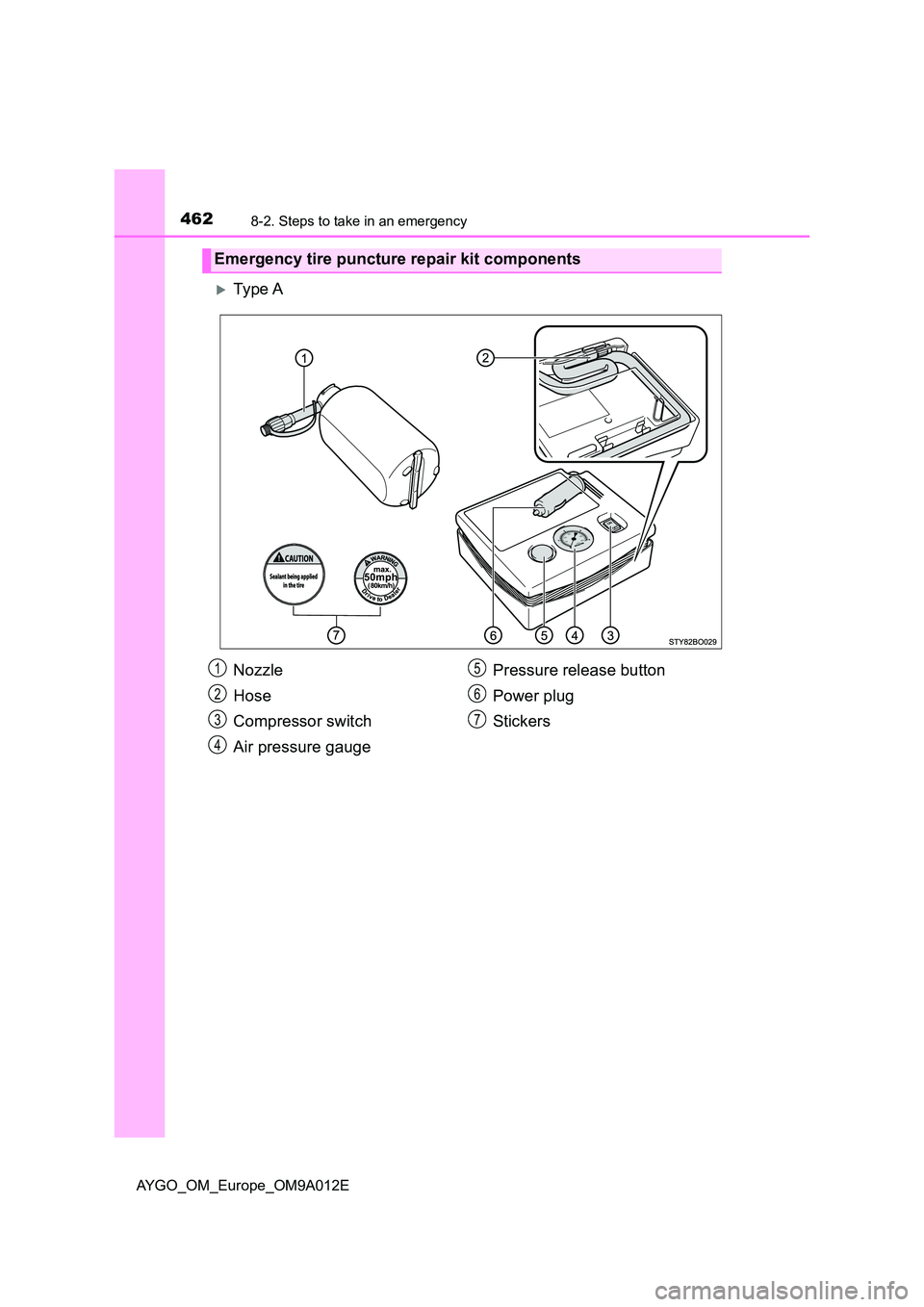
4628-2. Steps to take in an emergency
AYGO_OM_Europe_OM9A012E
Ty pe A
Emergency tire puncture repair kit components
Nozzle
Hose
Compressor switch
Air pressure gauge
Pressure release button
Power plug
Stickers
1
2
3
4
5
6
7